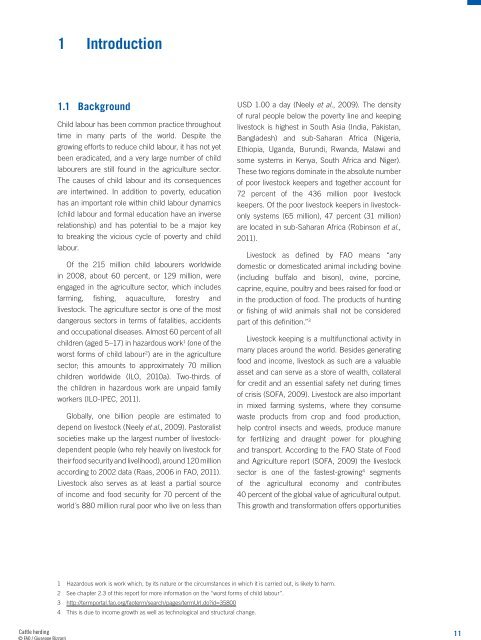Children’s work in the livestock sector: Herding and beyond
Children’s work in the livestock sector: Herding and beyond
Children’s work in the livestock sector: Herding and beyond
You also want an ePaper? Increase the reach of your titles
YUMPU automatically turns print PDFs into web optimized ePapers that Google loves.
Cattle herd<strong>in</strong>g<br />
1 Introduction<br />
1.1 Background<br />
Child labour has been common practice throughout<br />
time <strong>in</strong> many parts of <strong>the</strong> world. Despite <strong>the</strong><br />
grow<strong>in</strong>g efforts to reduce child labour, it has not yet<br />
been eradicated, <strong>and</strong> a very large number of child<br />
labourers are still found <strong>in</strong> <strong>the</strong> agriculture <strong>sector</strong>.<br />
The causes of child labour <strong>and</strong> its consequences<br />
are <strong>in</strong>tertw<strong>in</strong>ed. In addition to poverty, education<br />
has an important role with<strong>in</strong> child labour dynamics<br />
(child labour <strong>and</strong> formal education have an <strong>in</strong>verse<br />
relationship) <strong>and</strong> has potential to be a major key<br />
to break<strong>in</strong>g <strong>the</strong> vicious cycle of poverty <strong>and</strong> child<br />
labour.<br />
Of <strong>the</strong> 215 million child labourers worldwide<br />
<strong>in</strong> 2008, about 60 percent, or 129 million, were<br />
engaged <strong>in</strong> <strong>the</strong> agriculture <strong>sector</strong>, which <strong>in</strong>cludes<br />
farm<strong>in</strong>g, fish<strong>in</strong>g, aquaculture, forestry <strong>and</strong><br />
<strong>livestock</strong>. The agriculture <strong>sector</strong> is one of <strong>the</strong> most<br />
dangerous <strong>sector</strong>s <strong>in</strong> terms of fatalities, accidents<br />
<strong>and</strong> occupational diseases. Almost 60 percent of all<br />
children (aged 5–17) <strong>in</strong> hazardous <strong>work</strong>1 (one of <strong>the</strong><br />
worst forms of child labour2 ) are <strong>in</strong> <strong>the</strong> agriculture<br />
<strong>sector</strong>; this amounts to approximately 70 million<br />
children worldwide (ILO, 2010a). Two-thirds of<br />
<strong>the</strong> children <strong>in</strong> hazardous <strong>work</strong> are unpaid family<br />
<strong>work</strong>ers (ILO-IPEC, 2011).<br />
Globally, one billion people are estimated to<br />
depend on <strong>livestock</strong> (Neely et al., 2009). Pastoralist<br />
societies make up <strong>the</strong> largest number of <strong>livestock</strong>dependent<br />
people (who rely heavily on <strong>livestock</strong> for<br />
<strong>the</strong>ir food security <strong>and</strong> livelihood), around 120 million<br />
accord<strong>in</strong>g to 2002 data (Raas, 2006 <strong>in</strong> FAO, 2011).<br />
Livestock also serves as at least a partial source<br />
of <strong>in</strong>come <strong>and</strong> food security for 70 percent of <strong>the</strong><br />
world´s 880 million rural poor who live on less than<br />
USD 1.00 a day (Neely et al., 2009). The density<br />
of rural people below <strong>the</strong> poverty l<strong>in</strong>e <strong>and</strong> keep<strong>in</strong>g<br />
<strong>livestock</strong> is highest <strong>in</strong> South Asia (India, Pakistan,<br />
Bangladesh) <strong>and</strong> sub-Saharan Africa (Nigeria,<br />
Ethiopia, Ug<strong>and</strong>a, Burundi, Rw<strong>and</strong>a, Malawi <strong>and</strong><br />
some systems <strong>in</strong> Kenya, South Africa <strong>and</strong> Niger).<br />
These two regions dom<strong>in</strong>ate <strong>in</strong> <strong>the</strong> absolute number<br />
of poor <strong>livestock</strong> keepers <strong>and</strong> toge<strong>the</strong>r account for<br />
72 percent of <strong>the</strong> 436 million poor <strong>livestock</strong><br />
keepers. Of <strong>the</strong> poor <strong>livestock</strong> keepers <strong>in</strong> <strong>livestock</strong>only<br />
systems (65 million), 47 percent (31 million)<br />
are located <strong>in</strong> sub-Saharan Africa (Rob<strong>in</strong>son et al.,<br />
2011).<br />
Livestock as def<strong>in</strong>ed by FAO means “any<br />
domestic or domesticated animal <strong>in</strong>clud<strong>in</strong>g bov<strong>in</strong>e<br />
(<strong>in</strong>clud<strong>in</strong>g buffalo <strong>and</strong> bison), ov<strong>in</strong>e, porc<strong>in</strong>e,<br />
capr<strong>in</strong>e, equ<strong>in</strong>e, poultry <strong>and</strong> bees raised for food or<br />
<strong>in</strong> <strong>the</strong> production of food. The products of hunt<strong>in</strong>g<br />
or fish<strong>in</strong>g of wild animals shall not be considered<br />
part of this def<strong>in</strong>ition.” 3<br />
Livestock keep<strong>in</strong>g is a multifunctional activity <strong>in</strong><br />
many places around <strong>the</strong> world. Besides generat<strong>in</strong>g<br />
food <strong>and</strong> <strong>in</strong>come, <strong>livestock</strong> as such are a valuable<br />
asset <strong>and</strong> can serve as a store of wealth, collateral<br />
for credit <strong>and</strong> an essential safety net dur<strong>in</strong>g times<br />
of crisis (SOFA, 2009). Livestock are also important<br />
<strong>in</strong> mixed farm<strong>in</strong>g systems, where <strong>the</strong>y consume<br />
waste products from crop <strong>and</strong> food production,<br />
help control <strong>in</strong>sects <strong>and</strong> weeds, produce manure<br />
for fertiliz<strong>in</strong>g <strong>and</strong> draught power for plough<strong>in</strong>g<br />
<strong>and</strong> transport. Accord<strong>in</strong>g to <strong>the</strong> FAO State of Food<br />
<strong>and</strong> Agriculture report (SOFA, 2009) <strong>the</strong> <strong>livestock</strong><br />
<strong>sector</strong> is one of <strong>the</strong> fastest-grow<strong>in</strong>g 4 segments<br />
of <strong>the</strong> agricultural economy <strong>and</strong> contributes<br />
40 percent of <strong>the</strong> global value of agricultural output.<br />
This growth <strong>and</strong> transformation offers opportunities<br />
1 Hazardous <strong>work</strong> is <strong>work</strong> which, by its nature or <strong>the</strong> circumstances <strong>in</strong> which it is carried out, is likely to harm.<br />
2 See chapter 2.3 of this report for more <strong>in</strong>formation on <strong>the</strong> “worst forms of child labour”.<br />
3 http://termportal.fao.org/faoterm/search/pages/termUrl.do?id=35800<br />
4 This is due to <strong>in</strong>come growth as well as technological <strong>and</strong> structural change.<br />
11


